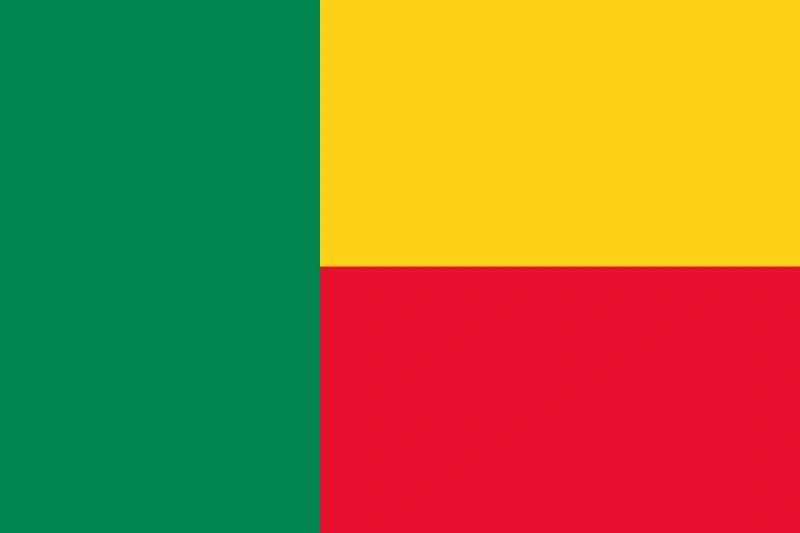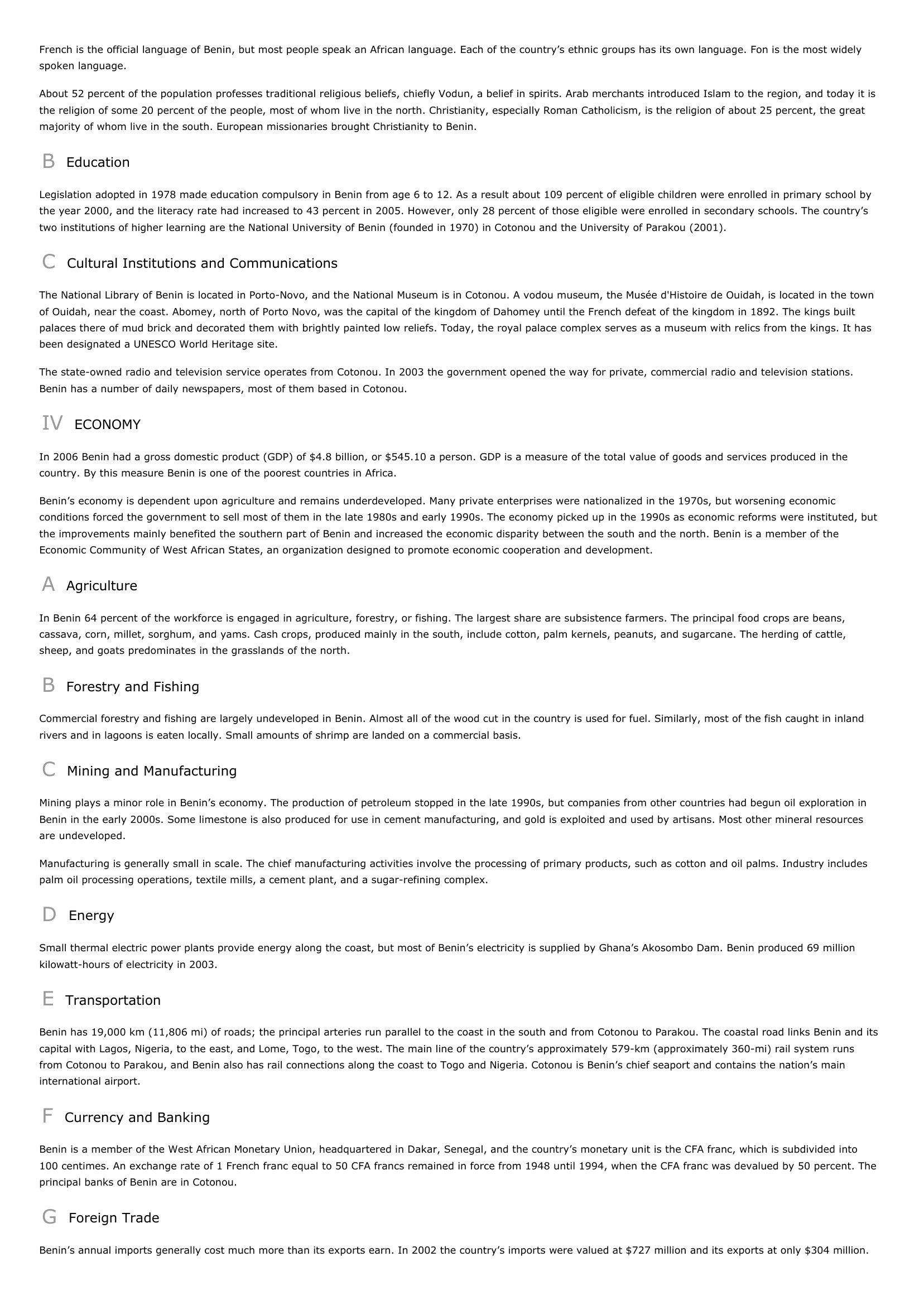Benin - country.
Publié le 04/05/2013
Extrait du document


«
French is the official language of Benin, but most people speak an African language.
Each of the country’s ethnic groups has its own language.
Fon is the most widelyspoken language.
About 52 percent of the population professes traditional religious beliefs, chiefly Vodun, a belief in spirits.
Arab merchants introduced Islam to the region, and today it isthe religion of some 20 percent of the people, most of whom live in the north.
Christianity, especially Roman Catholicism, is the religion of about 25 percent, the greatmajority of whom live in the south.
European missionaries brought Christianity to Benin.
B Education
Legislation adopted in 1978 made education compulsory in Benin from age 6 to 12.
As a result about 109 percent of eligible children were enrolled in primary school bythe year 2000, and the literacy rate had increased to 43 percent in 2005.
However, only 28 percent of those eligible were enrolled in secondary schools.
The country’stwo institutions of higher learning are the National University of Benin (founded in 1970) in Cotonou and the University of Parakou (2001).
C Cultural Institutions and Communications
The National Library of Benin is located in Porto-Novo, and the National Museum is in Cotonou.
A vodou museum, the Musée d'Histoire de Ouidah, is located in the townof Ouidah, near the coast.
Abomey, north of Porto Novo, was the capital of the kingdom of Dahomey until the French defeat of the kingdom in 1892.
The kings builtpalaces there of mud brick and decorated them with brightly painted low reliefs.
Today, the royal palace complex serves as a museum with relics from the kings.
It hasbeen designated a UNESCO World Heritage site.
The state-owned radio and television service operates from Cotonou.
In 2003 the government opened the way for private, commercial radio and television stations.Benin has a number of daily newspapers, most of them based in Cotonou.
IV ECONOMY
In 2006 Benin had a gross domestic product (GDP) of $4.8 billion, or $545.10 a person.
GDP is a measure of the total value of goods and services produced in thecountry.
By this measure Benin is one of the poorest countries in Africa.
Benin’s economy is dependent upon agriculture and remains underdeveloped.
Many private enterprises were nationalized in the 1970s, but worsening economicconditions forced the government to sell most of them in the late 1980s and early 1990s.
The economy picked up in the 1990s as economic reforms were instituted, butthe improvements mainly benefited the southern part of Benin and increased the economic disparity between the south and the north.
Benin is a member of theEconomic Community of West African States, an organization designed to promote economic cooperation and development.
A Agriculture
In Benin 64 percent of the workforce is engaged in agriculture, forestry, or fishing.
The largest share are subsistence farmers.
The principal food crops are beans,cassava, corn, millet, sorghum, and yams.
Cash crops, produced mainly in the south, include cotton, palm kernels, peanuts, and sugarcane.
The herding of cattle,sheep, and goats predominates in the grasslands of the north.
B Forestry and Fishing
Commercial forestry and fishing are largely undeveloped in Benin.
Almost all of the wood cut in the country is used for fuel.
Similarly, most of the fish caught in inlandrivers and in lagoons is eaten locally.
Small amounts of shrimp are landed on a commercial basis.
C Mining and Manufacturing
Mining plays a minor role in Benin’s economy.
The production of petroleum stopped in the late 1990s, but companies from other countries had begun oil exploration inBenin in the early 2000s.
Some limestone is also produced for use in cement manufacturing, and gold is exploited and used by artisans.
Most other mineral resourcesare undeveloped.
Manufacturing is generally small in scale.
The chief manufacturing activities involve the processing of primary products, such as cotton and oil palms.
Industry includespalm oil processing operations, textile mills, a cement plant, and a sugar-refining complex.
D Energy
Small thermal electric power plants provide energy along the coast, but most of Benin’s electricity is supplied by Ghana’s Akosombo Dam.
Benin produced 69 millionkilowatt-hours of electricity in 2003.
E Transportation
Benin has 19,000 km (11,806 mi) of roads; the principal arteries run parallel to the coast in the south and from Cotonou to Parakou.
The coastal road links Benin and itscapital with Lagos, Nigeria, to the east, and Lome, Togo, to the west.
The main line of the country’s approximately 579-km (approximately 360-mi) rail system runsfrom Cotonou to Parakou, and Benin also has rail connections along the coast to Togo and Nigeria.
Cotonou is Benin’s chief seaport and contains the nation’s maininternational airport.
F Currency and Banking
Benin is a member of the West African Monetary Union, headquartered in Dakar, Senegal, and the country’s monetary unit is the CFA franc, which is subdivided into100 centimes.
An exchange rate of 1 French franc equal to 50 CFA francs remained in force from 1948 until 1994, when the CFA franc was devalued by 50 percent.
Theprincipal banks of Benin are in Cotonou.
G Foreign Trade
Benin’s annual imports generally cost much more than its exports earn.
In 2002 the country’s imports were valued at $727 million and its exports at only $304 million..
»
↓↓↓ APERÇU DU DOCUMENT ↓↓↓
Liens utiles
- LES CHANGEMENTS SIGNIFICATIFS D’HABITUDE ALIMENTAIRE EN RELATION AVEC LE DEVELOPPEMENT DES MALADIES NUTRITIONNELLES AU BENIN ET DANS LE MONDE
- LA MUSIQUE COUNTRY
- Country- und Western-Musik - Musik.
- Pays noir, en anglais Black Country, terme imagé désignant les régions industrielles fondées sur l'extraction du charbon depuis l'époque de la révolution industrielle.
- Benin - geographie.


